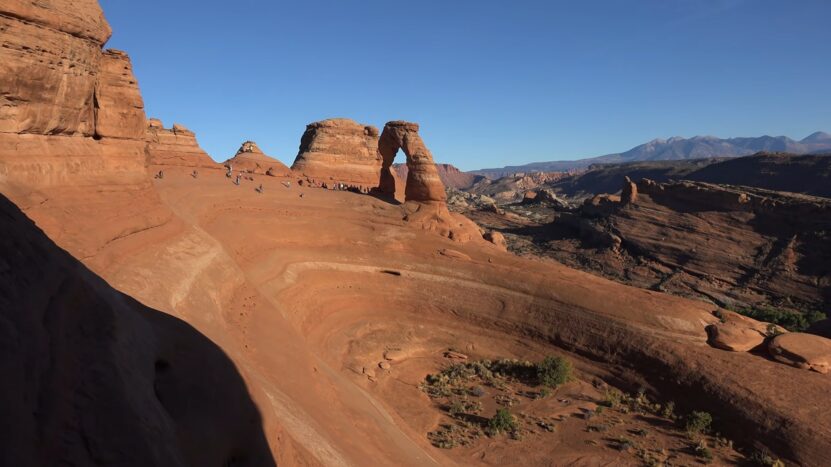Arches National Park Facts! This article provides you with 10 amazing facts about one of America’s most magnificent national parks.
I’ve been to so many of these amazing places since retiring from teaching in 2018.
Did I mention that I taught history?
I spent a lifetime teaching about the history behind some of these natural wonders.
Then I got to see them firsthand. And now I’m sharing some of the incredible stories about these beautiful places with you.
It doesn’t get any better than that!
More Than Just Parks takes a deeper dive with its national park facts. We’ve done our homework so that you’ll get more than you bargained for.
Without further ado, let’s dive in.
About
Arches National Park is a geological wonderland located in eastern Utah, encompassing over 76,000 acres of land. The park is renowned for its towering sandstone arches, natural bridges, spires, and other unique rock formations that have been shaped by millions of years of erosion and weathering.
One of the most remarkable things about Arches National Park is that it contains the highest concentration of natural arches in the world, with over 2,000 documented arches within its borders. Many of these arches are accessible via hiking trails or scenic drives, providing visitors with breathtaking views and endless photo opportunities.
But the park isn’t just about its natural beauty – it also has a rich cultural history. The area has been inhabited by various Native American tribes for thousands of years, with evidence of human presence dating back to 10,000 BCE. Later, European explorers and settlers made their way to the area, leaving behind a legacy of mining and ranching.
Today, Arches National Park is a beloved destination for nature lovers, hikers, photographers, and adventure seekers. With its stunning landscapes, diverse wildlife, and fascinating history, it’s no wonder that Arches National Park attracts millions of visitors each year.
Arches National Park facts boggle the minds of most because of the way the arches were formed. It is also a geological fantasy for anyone who loves natural wonders.
Exploring the Park: 10 Fascinating Things to Discover
1. Total Size

It is a geological wonderland located in eastern Utah, spanning over 76,000 acres of land. The park is renowned for its towering sandstone arches, natural bridges, spires, and other unique rock formations that have been shaped by millions of years of erosion and weathering.
To put the size of the park into perspective, it is roughly equivalent to the size of 57,600 football fields or over 300,000 tennis courts. It’s a vast and expansive area, with seemingly endless opportunities for exploration and adventure.
Despite its size, the park is easily accessible via a main road that winds its way through the heart of the park, providing visitors with stunning views of the surrounding landscape. Along the way, there are numerous pullouts and overlooks where you can stop and take in the beauty of the park.
But to truly experience the size and scale of Arches National Park, you need to lace up your hiking boots and hit the trails. With over 2,000 documented arches within its borders, there are countless opportunities to explore and discover hidden gems throughout the park.
It was first made available to visitors in 1923. Now, more than 1 million arrive each year.
2. Trails
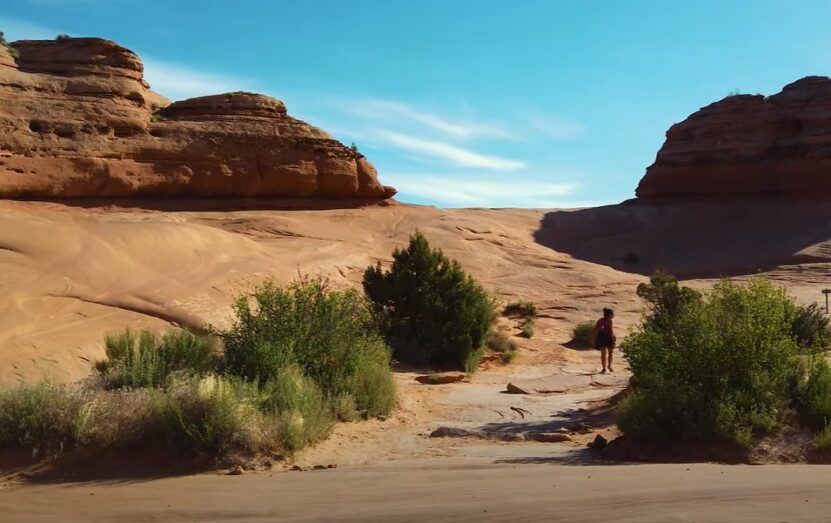
Arches National Park is home to a variety of hiking trails that wind their way through its stunning landscapes, offering visitors an opportunity to explore the park’s unique rock formations and natural wonders. Here are some of the most popular trails in Arches National Park:
- Delicate Arch Trail – This 3-mile round trip trail is one of the most popular hikes in the park and leads hikers to the iconic Delicate Arch, a towering sandstone arch that has become a symbol of the state of Utah.
- Landscape Arch Trail – This 1.6-mile round-trip trail takes visitors to Landscape Arch, which is one of the longest natural arches in the world.
- Devil’s Garden Trail – This 7.2-mile loop trail is the longest and most challenging hike in the park, taking hikers through a stunning landscape of rock formations and arches.
- Park Avenue Trail – This 1-mile trail takes visitors on a scenic walk through a canyon of towering rock formations that resemble skyscrapers.
- Balanced Rock Trail – This easy 0.3-mile loop trail takes visitors to the iconic Balanced Rock, a unique rock formation that appears to be balancing precariously on a narrow pedestal.
- Double Arch Trail – This easy 0.5-mile round-trip trail takes visitors to a unique formation where two arches have formed side by side, creating a spectacular sight.
- Fiery Furnace Trail – This challenging 2-mile loop trail takes visitors through a maze of towering rock formations, narrow canyons, and hidden arches.
These are just a few of the many hiking trails available. Visitors can choose from easy, moderate, and challenging trails, each offering a unique perspective on the park’s stunning landscapes and rock formations.
Whether you’re a seasoned hiker or just looking for a leisurely stroll, there’s a trail in Arches National Park that’s sure to suit your needs.
3. History

Evidence of human presence in the area dates back to at least 10,000 BCE, with the Archaic people occupying the region and using it for hunting and gathering. Later, the Fremont people settled in the area and began farming and hunting, leaving behind rock art and structures.
In the 16th century, Spanish explorers were the first Europeans to visit the area. They named the nearby Colorado River “Rio de los Arcos” (River of the Arches) and the name eventually became associated with the area that is now Arches National Park.
The land that makes up Arches National Park was originally part of the Ute Indian Reservation. In the late 1800s, the first Euro-American settlers began arriving in the area and established a small community known as Moab. The town was initially focused on ranching and mining activities, but with the arrival of the automobile and the construction of improved roads, tourism began to play an increasingly important role in the local economy.
In the 1920s, the area that is now Arches National Park was designated as a national monument by President Herbert Hoover. In 1971, President Richard Nixon signed legislation designating the area as a national park. Today, the park is a beloved destination for tourists and nature lovers from around the world.
4. Temperature

Monsoon season is from July through September, which can bring heavy rainfall, flash floods, and other weather-related challenges to the park. While the park is generally a safe and enjoyable destination year-round, it’s important to be aware of the potential hazards and difficulties that can arise during this time.
One of the primary challenges of the monsoon season is the risk of flash flooding. Heavy rainfall can quickly turn dry washes and arroyos into raging torrents, making them dangerous for hikers and drivers alike. Visitors are advised to check weather reports and park conditions before venturing out, and to avoid entering narrow canyons or other areas that are susceptible to flash floods.
The park’s trails and roads can also become more difficult to navigate during the monsoon season. Mud and debris can accumulate on roads and make driving hazardous, while slick rock surfaces can become slippery and treacherous for hikers. Visitors should take extra caution when hiking or driving in wet conditions, and be prepared for the possibility of trail and road closures.
5. Skyline Arch

It is one of the most popular and easily accessible arches in the park, with a short hiking trail leading directly to the arch.
Skyline Arch is unique in that it is located at the end of a relatively narrow, winding canyon, which makes it feel more secluded and intimate than some of the other arches in the park. The arch itself is a thin, delicate-looking structure that spans 69 feet, and it is located high up on a cliff face, which makes it a breathtaking sight to behold.
To reach Skyline Arch, visitors can take a short, 0.4-mile round trip trail that begins at the Devils Garden trailhead. The trail is relatively easy, with only a slight incline, and it offers stunning views of the surrounding red rock formations and the park’s beautiful desert landscape.
6. Tower of Babel
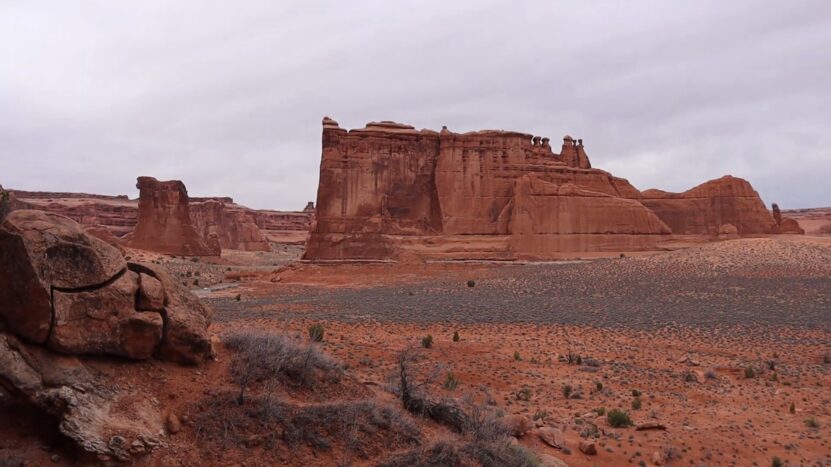
It is named after the biblical story of the Tower of Babel, which tells of a group of people who attempted to build a tower to the heavens in order to reach God.
The Tower of Babel is made up of several towering rock spires, which resemble the tiers of a towering structure. The tallest spire reaches a height of 480 feet, making it one of the most impressive and awe-inspiring rock formations in the park.
While the Tower of Babel is an impressive sight to behold, it is not easily accessible to park visitors. There are no official trails leading to the formation, and visitors who wish to view it must either hike cross-country or hire a guide to lead them to the site.
Despite its relative inaccessibility, the Tower of Babel is a popular destination for experienced hikers and rock climbers who are up for the challenge of navigating the rugged terrain to reach this iconic rock formation. Visitors who do make the trek are rewarded with breathtaking views of the surrounding landscape and a sense of awe and wonder at the natural beauty and power of the rock formations in Arches National Park.
7. Wildlife
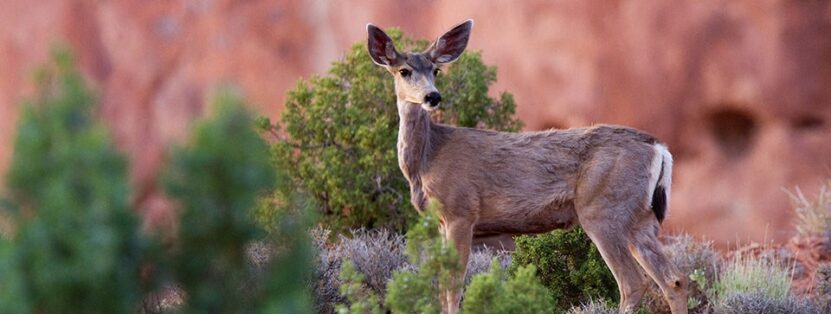
Visitors to the park may have the opportunity to observe and learn about animals in their natural habitat, but it’s important to remember to respect the wildlife and follow park guidelines to ensure their safety and well-being.
One of the most commonly observed animals in the park is the desert bighorn sheep. These majestic animals are well-adapted to life in the desert and can often be seen scaling the rocky cliffs and formations in search of food and water. Visitors are advised to keep a safe distance from bighorn sheep and avoid disturbing their natural behavior.
Other common wildlife species in Arches National Park include mule deer, coyotes, black-tailed jackrabbits, and a variety of lizards and snakes. Visitors should be aware of the potential risks associated with encountering these animals, such as bites or attacks, and should take precautions to avoid disturbing or provoking them.
In addition to the park’s resident wildlife species, Arches National Park is also an important migratory corridor for birds and other animals. Visitors may have the opportunity to observe a variety of bird species passing through the park during their annual migrations, including golden eagles, peregrine falcons, and many others.
8. Each Natural Arch Will Fall Someday

It’s a sad but true fact that each natural arch will eventually fall someday. These iconic rock formations are the result of millions of years of geological activity, and their unique shapes and sizes are constantly changing due to the forces of erosion and weathering.
While it can be disheartening to think about the inevitable demise of these beautiful natural wonders, it’s also a reminder of the fleeting nature of all things in life. Each arch that falls is a testament to the power of nature and the constant cycle of creation and destruction that shapes our world.
Fortunately, visitors to can still enjoy these magnificent arches while they last. By following park guidelines and taking care to avoid damaging or disturbing the fragile desert environment, we can help to preserve these natural wonders for future generations to enjoy.
9. When A New Arch Is Discovered, the Name Is Provided by The Discoverer.

Did you know that when a new arch is discovered in Arches National Park, the discoverer gets to name it? This tradition has been in place since the park’s founding in 1929 and has resulted in some creative and memorable names for these iconic rock formations.
The naming process is fairly straightforward. When a new arch is discovered, the person who found it can submit a proposed name to the park service for approval. The park service considers factors such as the arch’s location, appearance, and cultural or historical significance when deciding whether to approve the proposed name.
Over the years, some of the most memorable arch names in the park have included Double O Arch, Landscape Arch, and the infamous Delicate Arch, which has become an iconic symbol of the park and the state of Utah.
Of course, with over 2,000 arches located within the park’s boundaries, there are still plenty of opportunities for new discoveries and creative naming conventions. Who knows what new arches will be discovered and named in the years to come?
So the next time you visit and come across an arch with a unique or interesting name, remember that it was likely named by the person who first discovered it, and that this tradition of creative naming has been an important part of the park’s history and culture for nearly a century.
10. Hidden Messages Painted on the Rocks
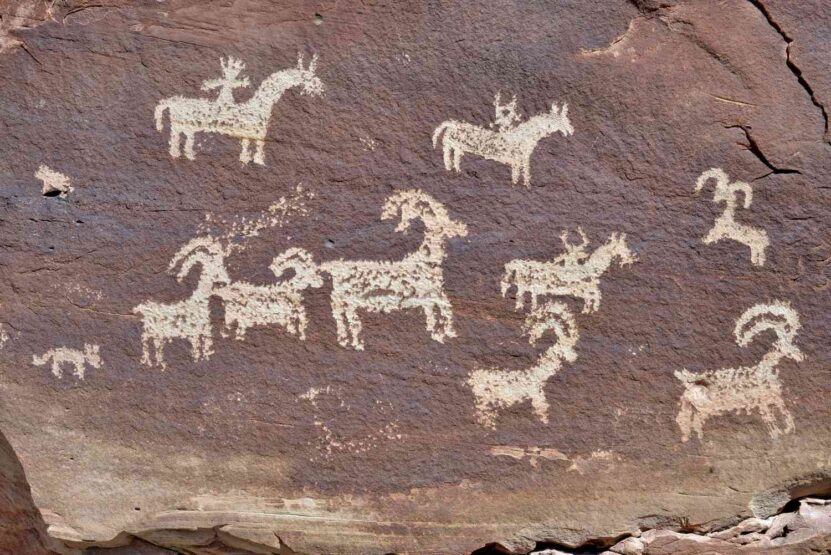
Did you know that there are hidden messages painted on the rocks? While most visitors are content to simply admire the park’s stunning natural beauty, some have discovered that there is much more to the park than meets the eye.
For years, visitors have reported seeing strange symbols and markings on the rocks throughout the park, some of which appear to have been painted on deliberately. These mysterious messages have sparked the imaginations of many, and have led some to speculate about their meaning and origin.
While there is no official explanation for these markings, some believe that they may be the work of ancient cultures or even extraterrestrial visitors. Others speculate that they may be the work of more recent visitors to the park, who have left their mark as a way of asserting their presence in the landscape.
Tips for Visiting
Are you planning a trip? Here are some tips to help you make the most of your visit:
- Plan ahead: Arches National Park can get crowded during peak season, so it’s best to plan your visit in advance. Consider visiting during the off-season or arriving early in the morning to avoid crowds.
- Bring plenty of water: The desert environment can be harsh, so be sure to bring plenty of water to stay hydrated throughout your visit.
- Wear appropriate clothing and footwear: The weather in Arches National Park can be unpredictable, so be sure to wear layers and bring a hat and sunscreen. Wear comfortable shoes suitable for hiking on rocky terrain.
- Respect the environment: The delicate desert ecosystem in the park is easily disrupted, so be sure to stay on designated trails and avoid disturbing wildlife or plant life.
- Stay safe: The park can be dangerous if you’re not careful, so be sure to stay on marked trails, avoid steep drops and watch your footing.
- Take advantage of ranger-led programs: The park offers a variety of ranger-led programs and guided tours, which can provide valuable insight and information about the park’s history, geology, and ecology.
- Bring a camera: Arches National Park is home to some of the most stunning natural landscapes in the world, so be sure to bring a camera to capture the beauty of the park.
Best Time to Visit
To make the most of your visit to Arches National Park, it’s important to plan accordingly and be aware of the weather conditions during different seasons. The climate in Arches varies greatly from spring, summer, fall, and winter.
During the spring months, temperatures can fluctuate significantly from one month to the next. It’s recommended to pack for all types of weather since the weather can be unpredictable. In March, it’s not uncommon to experience rain or even snowfall. If you plan on visiting during early spring, it’s wise to bring a winter coat, hat, and gloves. A fleece jacket, hat, and gloves should suffice for later in the season.
Arches in March: Highs 64 | Lows 35 degrees F
Arches in April: Highs 71 | Lows 42 degrees F
Arches in May: Highs 82 | Lows 51 degrees F
Summer weather in Arches can be extremely hot, making it essential to plan your outdoor activities during the cooler mornings and evenings. Protect yourself from the sun’s harmful rays by wearing a sunhat, sunscreen, and sunglasses. Additionally, it’s important to stay hydrated and carry a hydration pack or refillable water bottle in your backpack.
Arches in June: Highs 93 | Lows 60 degrees F
Arches in July: Highs 100 | Lows 67 degrees F
Arches in August: Highs 97 | Lows 66 degrees F
As fall approaches, the weather begins to cool down, making it an excellent time to explore the park. With cooler temperatures at night, bringing a fleece jacket, warm hat, and gloves for the evenings and early mornings is highly recommended.
Arches in September: Highs 85 | Lows 54 degrees F
Arches in October: Highs 71 | Lows 40 degrees
F Arches in November: Highs 55 | Lows 30 degrees F
During the winter months, it’s essential to dress in layers since the weather can be quite cold. While the visitor services are reduced during the winter, it’s still a great time to visit Arches National Park if you’re well-prepared. An insulated winter jacket, fleece jacket, warm hat, and gloves are recommended for outside activities.
Arches in December: Highs 45 | Lows 23 degrees F
Arches in January: Highs 44 | Lows 22 degrees F
Arches in February: Highs 52 | Lows 28 degrees F
FAQs
How Many People Visit Arches National Park per Year?
According to the National Park Service, Arches National Park receives over 1.7 million visitors each year. It is one of the most popular national parks in the United States and attracts visitors from all over the world who come to see the park’s unique sandstone arches and stunning natural beauty.
The park is busiest during the summer months, with peak visitation in June, July, and August. However, visitors can enjoy the park’s beauty and avoid the crowds by visiting during the off-season, such as in the fall or winter.
What Is Unique About Arches National Park?
It is unique for its more than 2,000 natural sandstone arches, along with other unique geological formations like pinnacles, fins, and balanced rocks. It also boasts a diverse ecosystem with a variety of plant and animal species, including desert bighorn sheep and prickly pear cacti.
The park has a rich history with evidence of human habitation dating back 10,000 years, as well as historic structures and cultural sites from the early 1900s.
Can You Drive Through Arches?
Yes, you can drive through Arches National Park. There is a scenic drive called the Arches Scenic Drive that allows visitors to explore the park by car. The drive is a 36-mile round-trip and takes visitors past many of the park’s most popular sights, including Balanced Rock, The Windows Section, and Delicate Arch.
However, there are some areas of the park that are only accessible by hiking trails.
Who Is the Most Famous Person Associated with Arches National Park?
Author and environmentalist Edward Abbey might be one of the most famous people associated with the park. His passion for the area and his book, Desert Solitaire shined a light on Arches and the whole area around Moab.
How Many Types of Birds Are in Arches?
There are approximately 276 species of birds that have been observed in Arches National Park, according to the National Park Service.
Some of the common bird species found in the park include ravens, golden eagles, pinyon jays, juniper titmice, and rock wrens.
What Endangered Species Are National Park?
Arches is home to several endangered species, including the Colorado pikeminnow, razorback sucker, and humpback chub, which are all fish species found in the Colorado River and its tributaries. The park also provides habitat for the endangered Mexican spotted owl and the threatened Peregrine falcon, which are bird species. Additionally, the park is home to the desert tortoise, a threatened species, and the Utah prairie dog, a species of concern.
How Many Movies Were Filmed in Arches National Park?
According to the National Park Service, more than 60 movies and numerous commercials and TV shows have been filmed in the park since the 1950s. Some of the most famous movies filmed in the park include “Thelma & Louise,” “Indiana Jones and the Last Crusade,” and “Mission: Impossible II.”

